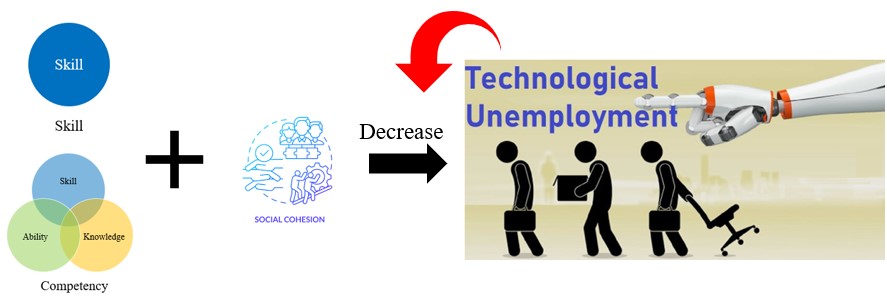Book: Data-Driven Innovation Big Data for Growth and Well-Being
Chapter 6: Skills and employment in a data-driven economy.
Page No. # 272 – 293
Presenter: NORASING Anouluck
Date: 07/07/2022
Keywords: technological unemployment, developing skills, income equality.
This week’s book discussion is still in chapter 6, but we discuss the rest of this chapter (6.3 & 6.4). There are two main parts: promoting DDI and smoothing structural change, key findings and policy conclusions.
- SUMMARY OF PRESENTATION
Initially, the book describes that DDI is a fresh source of expansion that has the potential to increase all sectors of the economy’s competitiveness and productivity. However, as indicated in the previous section (6.1 & 6.2), DDI is still disruptive with the potential for creative destruction in labor markets that policymakers need permanent and cautious observation.
Promoting DDI and smoothing structural change
Inequality could become a significant problem. Particularly access to high-quality education is urgently required to take advantage of the job creation opportunities, which are limited to a few. In the context of DDI, it may also result in technological unemployment that is still up for dispute in academia.
To solve those issues, this section describes a “Double Strategy” discussed by Herlyn et al., 2015. They are two tasks to decrease technological unemployment: initial, support development and strengthen the right mix of skills and competencies needed, including data specialist skills. Following promotes social cohesion while addressing the risk of inequality.
Figure 1: Double strategy
To describe the implications of DDI in this chapter, humans will need education as a basis for the accelerated race ahead to further enhance the competitive advantage over machines. By perfecting the talents/skills that devices will not be able to accomplish at the higher level, such as creative thinking, problem-solving, and communication skills. This chapter also describes how to utilize these abilities more effectively and stimulate the supply of those needed for the data-driven economy. Last, more consideration is required to understand how to provide people a competitive edge over machines.
Policy consideration may be needed for improving skills to smooth structure change and address the inequality that could increase due to DDI. Evidence shows that reducing income inequality would boost economic growth (OECD, 2014e). The essential part that I would like to highlight is Cingano, 2014, “To promote equality in access to opportunities and quality of education is the way to solve those issues.” Lack of investment in education is the primary mechanism by which growth is restricted due to inequality. For example, children from poor socio-economic backgrounds, a lack of investment in education, and lower social mobility can hamper their skills development, thereby negatively affecting growth potential in the long run.
Key findings and policy conclusion
Key findings:
- DDI can be disruptive and potentially amplify employment polarization, affecting a broader range of middle-income jobs. Moreover, DDI can contribute to employment polarization affecting white-collar and blue-collar jobs. DDI may negatively affect some data specialist jobs, such as data entry clerks, database administrators, and statisticians. However, we cannot deny that technological change tends to increase productivity, reducing costs and increasing demand for goods and services, which can help generate more jobs in other parts of the economy.
- Further studies of DDI are needed to better/carefully understand the employment effects.
- This chapter points to current academic debates about the risks of DDI worsening wage and income inequalities as employment polarization.
Policy:
- This chapter clearly showed that investment in education is needed to promote the adoption of DDI across society and to support the development of skills and competence, as mentioned before, a “Double Strategy.”
- Developing relevant skills proficiency is essential to use data and analytics appropriately and deal with their limitations.
- There may be more significant advantages if individuals can enhance and complement their talents by using technology to “dance” with the machines instead of “racing” against them.
Furthermore, the chapter highlighted those soft skills such as creativity, problem-solving, and communication skills are the key to ensuring employment in a data-driven economy in the long run. Highly developed sensomotoric skills will also become a competitive advantage of humans over machines. These skills, if cultivated with the support of education systems and accompanied by political attention and good cooperative global governance, may lessen concerns related to technological unemployment.
- DISCUSSION AFTER THE PRESENTATION
- Technological unemployment: Is technology destroying jobs or creating them?
We discuss the problematic relationship between technology and unemployment. Are machines taking over our jobs? Are workers made obsolete by artificial intelligence and robots? Or is the impact of technology and innovation positive for the labor market? I think the answer will depend on the audience’s point of view. The phenomenon of machines replacing ordinary human beings in low or medium-wage jobs has gone into high gear. Artificial intelligence is also taking over many jobs. In other words, technology can also create new occupations, especially in data science fields. The demand is increasing each year, as evidenced in this book. As one comment from our group discussion, from the business owners’ point of view, the company wants to reduce the cost of human labor. Technology can make human work more manageable by reducing time and getting more products/services.
- Compared to the current situation, why does income/economic inequality matter?
As mentioned in the presentation, income inequality is related to economic growth. However, several factors cause income inequality, including technological change, globalization, the decline of unions, and the eroding value of the minimum wage. Whatever the causes, the increase in inequality has caused concern among public members, researchers, policymakers, and politicians.
